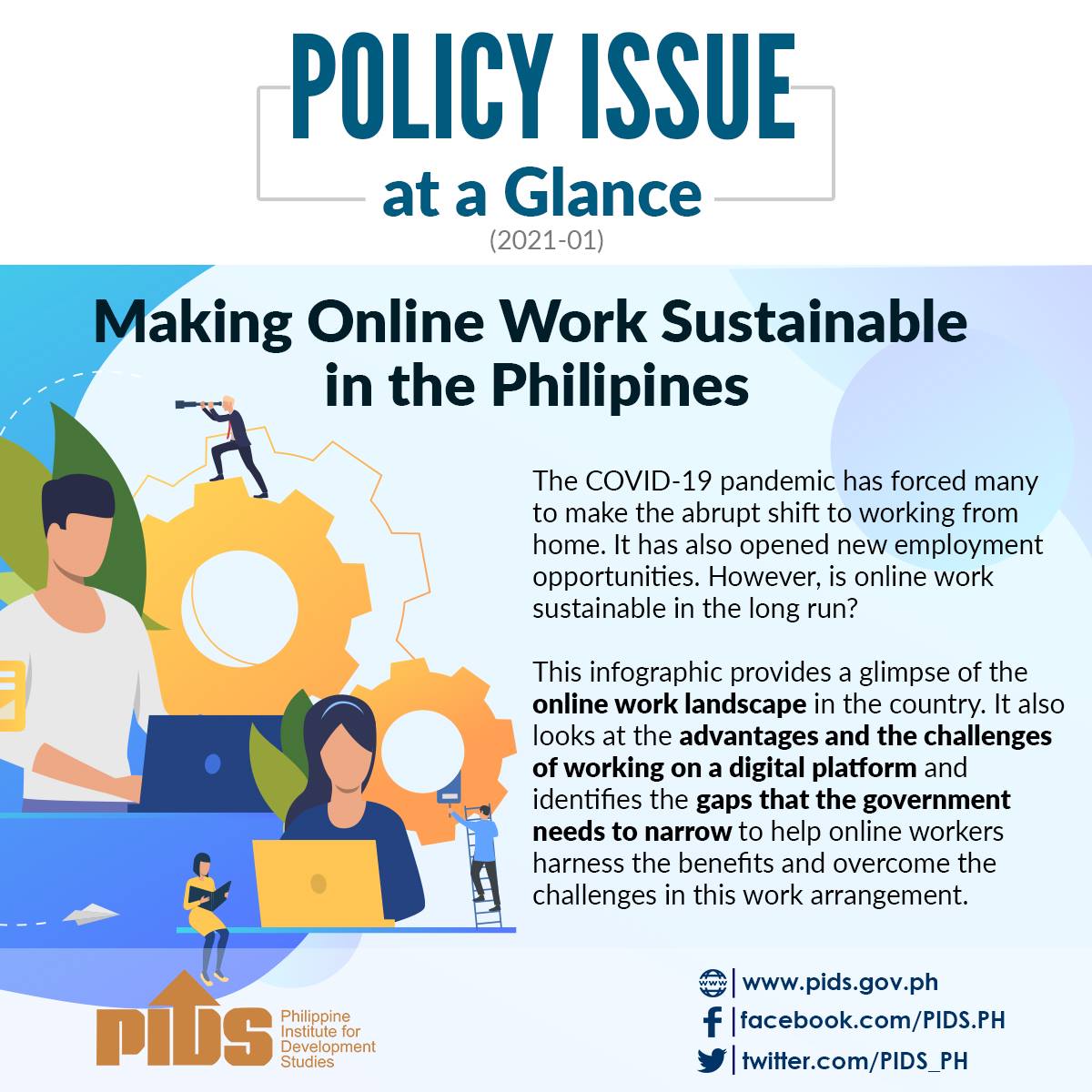FILIPINOS should avoid relying too much on online and kalye or street surveys as these are not statistically reliable, according to a fellow from the Philippine Institute for Development Studies (PIDS).
In his presentation at the 20th Jaime V. Ongpin Annual Memorial Lecture on Public Service in Business and Government, PIDS Senior Research Fellow Jose Ramon G. Albert said the election is now attracting more organizations to come up with surveys and circulating the results online.
However, Albert said, some of these new surveys may not be representative. The “kalye” or street surveys, which involves stopping people on the streets and getting their opinions, will not lead to a representative result for that locale or nationwide.
“Going out on the street and reportedly randomly picking people will not work to get a national reading or even a reliable reading of these areas as not every voter in a city may pass on that street and, what I think as a random selection, may not be random at all,” Albert said.
The media, he added, “is well-advised not to give credence to any polls that are not designed well to yield representativeness. This includes internet surveys—by the way, some media organizations have done these internet surveys—and other non-probability surveys which have their uses for qualitative research but they cannot give a national reading.”
Relying even on Google Trends, Albert said, may also yield unreliable results. He said results on Google Trends will significantly be affected by the words used in these posts which may skew results on who is leading Google Trends.
He noted that data on these big data sources may also be inflated by trolls “who are employed by all sides of the political spectrum.” The employment of the trolls, he said however, would depend on the size of the election “war chest” of a candidate.
“Big data sources like Google Trends are also unreliable for tracking national views. Since, first, not everyone is on the net and second, not everyone on the net knows how to Google. If Google Trends data would be a good representation of netizens, which I sincerely doubt, they would at best reflect the A-B crowd which is the upper 10 percent of the socioeconomic strata of the country,” Albert said.
Unfortunately, when the data from these unreliable surveys is consumed, it often leads the public to doubt the data released by reputable institutions.
These institutions would often use samples in their surveys of around 1,200 respondents. Albert said this often leads people to doubt the data since they do not even account for 10 percent of the 63 million voters in the Philippines.
Further, the danger also comes with the results of the actual elections. He recalled how in the United States in the 1930s, a survey of 2.4 million respondents incorrectly forecasted that Republican presidential candidate Alfred Landon would achieve a landslide victory over Franklin Delano Roosevelt.
The New York based Literary Digest forecasted 57 percent would vote for Landon while 43 percent would vote for Roosevelt. The actual election results showed the opposite, with 61 percent of Americans electing Roosevelt as their President in the 1936 US presidential polls.
The same also happened during the 2016 US Presidential elections where Hillary Clinton was forecasted to win over Donald Trump according to Nate Silver, the New York Times, the Princeton Election Consortium, and ABC News.
“But Trump vastly outperformed what everyone was anticipating from state and national polls, winning nearly all the tossup states plus a number of states predicted to favor Clinton,” Albert said in a presentation.
Albert said it is important for firms and other institutions to be transparent with their methods, including the identity of the survey’s financier.
It also requires the public to be critical—not skeptical—of the surveys and for politicians and their supporters to be open to survey results.
Forecasts of the outcome of elections, Albert said, may have more credence if conducted a month before the actual elections.
Institutions like the Social Weather Stations and Pulse Asia were able to approximate some of the results in the 2016 elections.
The media must develop skill sets to understand survey results and their limitations in order for them to better report on these studies.
“Surveys may not often offer explanations – on opinions and why opinions change – but we can conjecture and validate these with conversation,” Albert said.
Election conversations
The Philippine Media Monitoring Laboratory (PMM), a consortium of researchers in communication, political science and data science in the University of the Philippines, will be releasing three studies on the social media landscape for the 2022 Presidential polls. The studies, to be conducted through the Digital Public Pulse (DPP) project, will focus on how digital media is being used strategically by online users to influence election-related conversations.
The studies will be based on public posts on Facebook, Twitter, and YouTube—considered the largest social media platforms in the Philippines.
“[The DPP will look at social media conversations] to identify what topics and issues are most talked about and most resonant in social media and which candidates, political leaders and parties, organizations, and individuals lead online discussions in the run-up to the elections,” the PMM said in a statement. Using big data, computation methods and critical analysis, the DPP project collects hundreds of thousands of public content in social media to generate its database.
The first study, to be released in December, will focus on the Elections and the Philippines digital public sphere. The study aims to map the actors, networks and social structures in the digital public sphere.
The second report, for release in March 2022, will be on election issues and online political structures in the Philippines. It aims to identify key election messages, issues and debates as well as characterize political culture across platforms. The last study will be released after the elections in July 2022, with focus on the digital public pulse in the 2022 Philippine General Elections.
The last report will contain the full-year analysis of online election networks, issues, and cultures in the 2022 elections.
In his presentation at the 20th Jaime V. Ongpin Annual Memorial Lecture on Public Service in Business and Government, PIDS Senior Research Fellow Jose Ramon G. Albert said the election is now attracting more organizations to come up with surveys and circulating the results online.
However, Albert said, some of these new surveys may not be representative. The “kalye” or street surveys, which involves stopping people on the streets and getting their opinions, will not lead to a representative result for that locale or nationwide.
“Going out on the street and reportedly randomly picking people will not work to get a national reading or even a reliable reading of these areas as not every voter in a city may pass on that street and, what I think as a random selection, may not be random at all,” Albert said.
The media, he added, “is well-advised not to give credence to any polls that are not designed well to yield representativeness. This includes internet surveys—by the way, some media organizations have done these internet surveys—and other non-probability surveys which have their uses for qualitative research but they cannot give a national reading.”
Relying even on Google Trends, Albert said, may also yield unreliable results. He said results on Google Trends will significantly be affected by the words used in these posts which may skew results on who is leading Google Trends.
He noted that data on these big data sources may also be inflated by trolls “who are employed by all sides of the political spectrum.” The employment of the trolls, he said however, would depend on the size of the election “war chest” of a candidate.
“Big data sources like Google Trends are also unreliable for tracking national views. Since, first, not everyone is on the net and second, not everyone on the net knows how to Google. If Google Trends data would be a good representation of netizens, which I sincerely doubt, they would at best reflect the A-B crowd which is the upper 10 percent of the socioeconomic strata of the country,” Albert said.
Unfortunately, when the data from these unreliable surveys is consumed, it often leads the public to doubt the data released by reputable institutions.
These institutions would often use samples in their surveys of around 1,200 respondents. Albert said this often leads people to doubt the data since they do not even account for 10 percent of the 63 million voters in the Philippines.
Further, the danger also comes with the results of the actual elections. He recalled how in the United States in the 1930s, a survey of 2.4 million respondents incorrectly forecasted that Republican presidential candidate Alfred Landon would achieve a landslide victory over Franklin Delano Roosevelt.
The New York based Literary Digest forecasted 57 percent would vote for Landon while 43 percent would vote for Roosevelt. The actual election results showed the opposite, with 61 percent of Americans electing Roosevelt as their President in the 1936 US presidential polls.
The same also happened during the 2016 US Presidential elections where Hillary Clinton was forecasted to win over Donald Trump according to Nate Silver, the New York Times, the Princeton Election Consortium, and ABC News.
“But Trump vastly outperformed what everyone was anticipating from state and national polls, winning nearly all the tossup states plus a number of states predicted to favor Clinton,” Albert said in a presentation.
Albert said it is important for firms and other institutions to be transparent with their methods, including the identity of the survey’s financier.
It also requires the public to be critical—not skeptical—of the surveys and for politicians and their supporters to be open to survey results.
Forecasts of the outcome of elections, Albert said, may have more credence if conducted a month before the actual elections.
Institutions like the Social Weather Stations and Pulse Asia were able to approximate some of the results in the 2016 elections.
The media must develop skill sets to understand survey results and their limitations in order for them to better report on these studies.
“Surveys may not often offer explanations – on opinions and why opinions change – but we can conjecture and validate these with conversation,” Albert said.
Election conversations
The Philippine Media Monitoring Laboratory (PMM), a consortium of researchers in communication, political science and data science in the University of the Philippines, will be releasing three studies on the social media landscape for the 2022 Presidential polls. The studies, to be conducted through the Digital Public Pulse (DPP) project, will focus on how digital media is being used strategically by online users to influence election-related conversations.
The studies will be based on public posts on Facebook, Twitter, and YouTube—considered the largest social media platforms in the Philippines.
“[The DPP will look at social media conversations] to identify what topics and issues are most talked about and most resonant in social media and which candidates, political leaders and parties, organizations, and individuals lead online discussions in the run-up to the elections,” the PMM said in a statement. Using big data, computation methods and critical analysis, the DPP project collects hundreds of thousands of public content in social media to generate its database.
The first study, to be released in December, will focus on the Elections and the Philippines digital public sphere. The study aims to map the actors, networks and social structures in the digital public sphere.
The second report, for release in March 2022, will be on election issues and online political structures in the Philippines. It aims to identify key election messages, issues and debates as well as characterize political culture across platforms. The last study will be released after the elections in July 2022, with focus on the digital public pulse in the 2022 Philippine General Elections.
The last report will contain the full-year analysis of online election networks, issues, and cultures in the 2022 elections.












